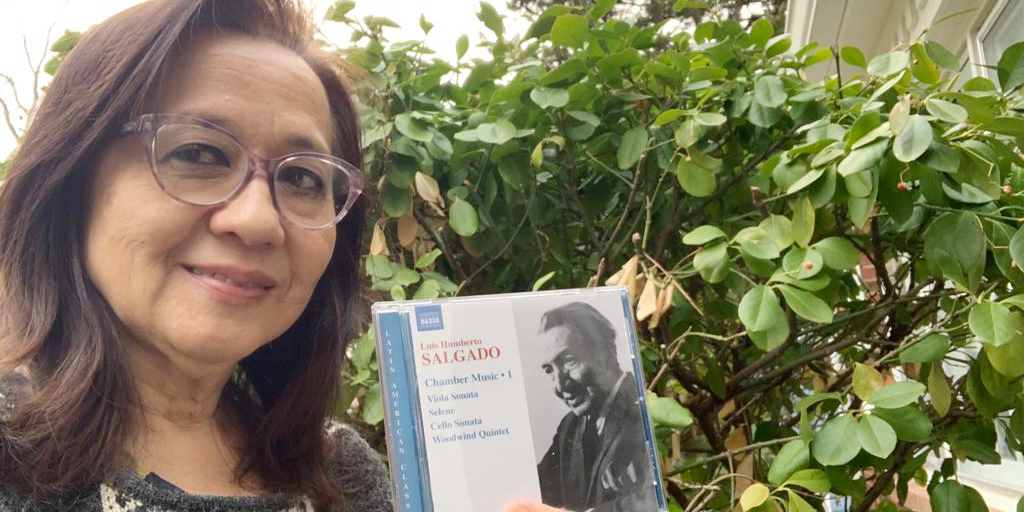Research, new recordings bring works of 20th century Ecuadorian composer to light

LAWRENCE – Ecuadorian composer Luis Humberto Salgado was so far ahead of his time that neither he nor the public in Quito, where he lived, heard most of his orchestral and chamber music works performed during his life (1903-1977).
“He wrote music for a large symphony orchestra that didn't exist yet in Ecuador,” said Ketty Wong, University of Kansas associate professor of ethnomusicology.
The compositions he wrote were inspired by Arnold Schoenberg’s 12-tone technique and existed only in Salgado’s mind and in handwritten paper form. For years after his death, the manuscripts languished in an heir’s closet.
But now a new project organized by Wong is bringing Salgado’s work to a worldwide audience. Not only has KU published and distributed 13 Salgado compositions for chamber music — set down in formal musical notation and with the instruments’ individual parts — for the first time, but School of Music faculty members have recorded four of the compositions for a new album issued on the Naxos label. A recording of six more compositions is scheduled for release in 2024.
The teaching musicians — pianist Ellen Sommer, cellist Hannah Collins, violinist David Colwell and violist Boris Vayner — and the musicologist traveled in October to Ecuador to present copies of the recordings and the sheet music to the Ministry of Culture and Heritage and to present concerts of Salgado’s music. They were hosted by the House of Music in the capital city, Quito, and University of the Arts in Guayaquil.
“Salgado is considered Ecuador’s most prominent composer because he was a pioneer in combining vernacular music with the avant-garde techniques of his time, and he did so in creative and idiosyncratic ways. He was also very prolific in his musical output,” said Wong, who is a native of Guayaquil. “He has nine symphonies like Beethoven, four operas, seven concertos and numerous works for piano and chamber ensemble. No other composer had approached these genres in Ecuador in the 1930s, ’40s and ’50s.”
He wrote works for a large symphony orchestra, and Ecuador didn’t have one until 1956, after Salgado had already composed his first three symphonies, and even then it was not large enough to perform Salgado’s major works completely, Wong said.
She said Salgado used folk motifs in his music but filtered them through Schoenberg’s dissonant system so that the public did not understand or recognize his portrayal of Ecuadorian music.
“He was a pianist, and he performed frequently in Quito,” Wong. “He was the director of the National Conservatory, where he taught music theory and harmony. He also had a newspaper column, where he published articles about his views on modern music in the 1960s and ’70s. So he was a public figure. People knew and respected him, but they didn't know his music.”
Wong said she was inspired by a 1989 issue of an Ecuadorian music journal dedicated to Salgado to begin the process of rectifying that. She reached out to Salgado’s heirs, who allowed her to photocopy two of his symphony manuscripts for her master’s degree research.
Despite the centenary of his birth in 2003, shortly after which Wong’s master’s thesis was published, and his heirs having sold his manuscripts, which wound up with the Ministry of Culture, most of Salgado’s music remained unpublished and unheard, Wong said.
“In 2017, there was suddenly an interest among symphony orchestra conductors to play new works by Ecuadorian composers,” she said. “They began to play the symphonies. And they all came to me to ask, ‘Where can I find the music scores? Can you tell me more about Salgado?’ Now his nine symphonies are recorded. They have been performed in Ecuador since 2017. And then I thought it was time to go back to Salgado and publish a book in English so that he and his music are better known outside of Ecuador.”
Wong is working on that book now.
Meanwhile, the School of Music backed her project, which resulted in the publication of the sheet music in 2020 and now the recordings and performances.
“The project was to make his music audible and accessible so that people can play it and enjoy it, because I think he's a composer that speaks to the time in which he lived,” Wong said.
For instance, one of his newly published compositions was inspired by the U.S. moon landing in 1969.
“Scholars have studied the effects of the 12-tone technique in the works of composers in the U.S. and Europe,” Wong said, “but we know little about how this technique was received in Latin America.”
Now that Salgado’s music is out there, Wong feels sure it will resonate.
“Musicians always look for new repertoire, and, especially given the push for diversity, musicians want to perform music of underrepresented composers,” she said.
Image: Ketty Wong holds a copy of the new Naxos CD featuring the chamber music of Luis Humberto Salgado. Credit: Courtesy Ketty Wong